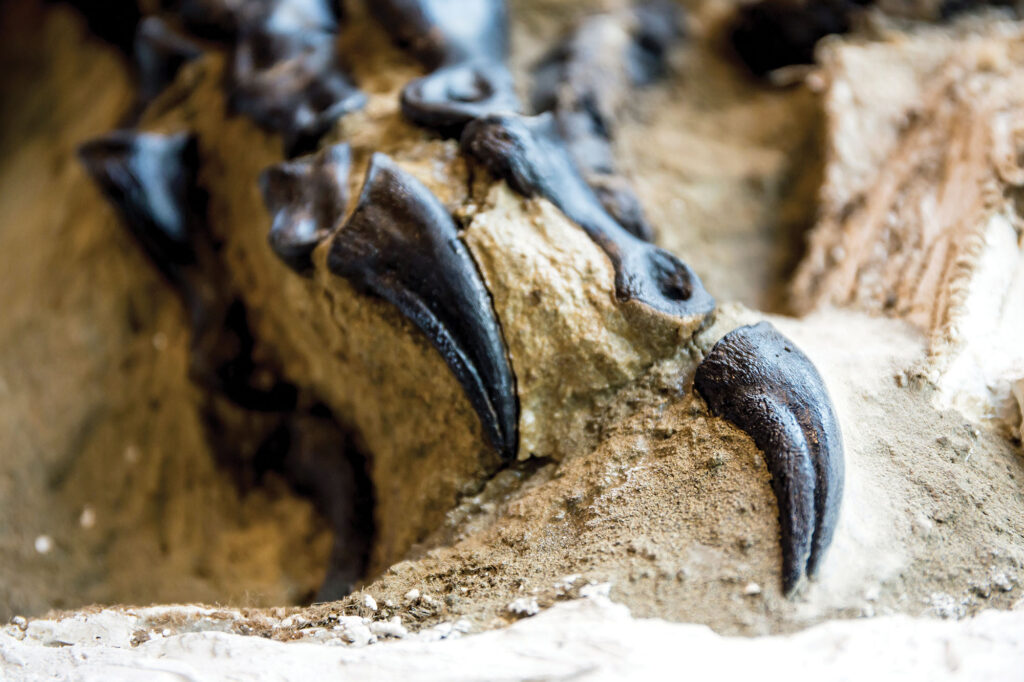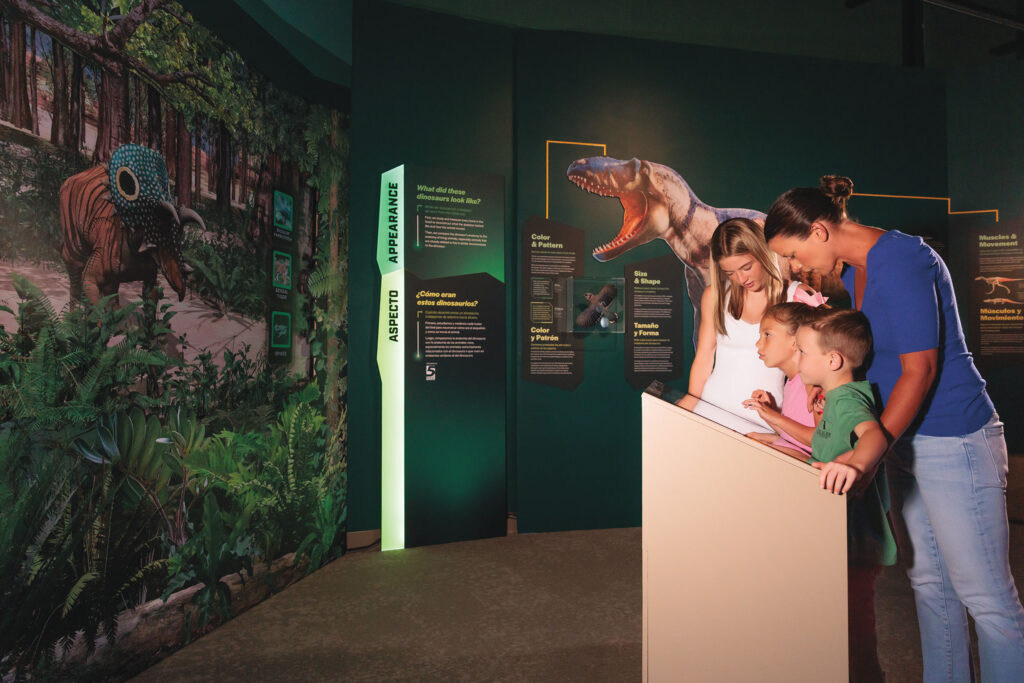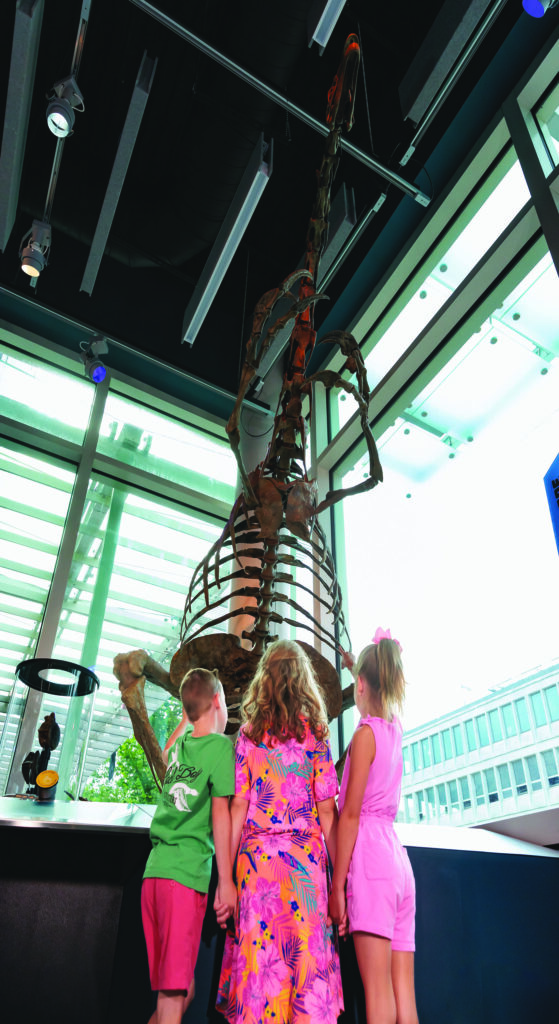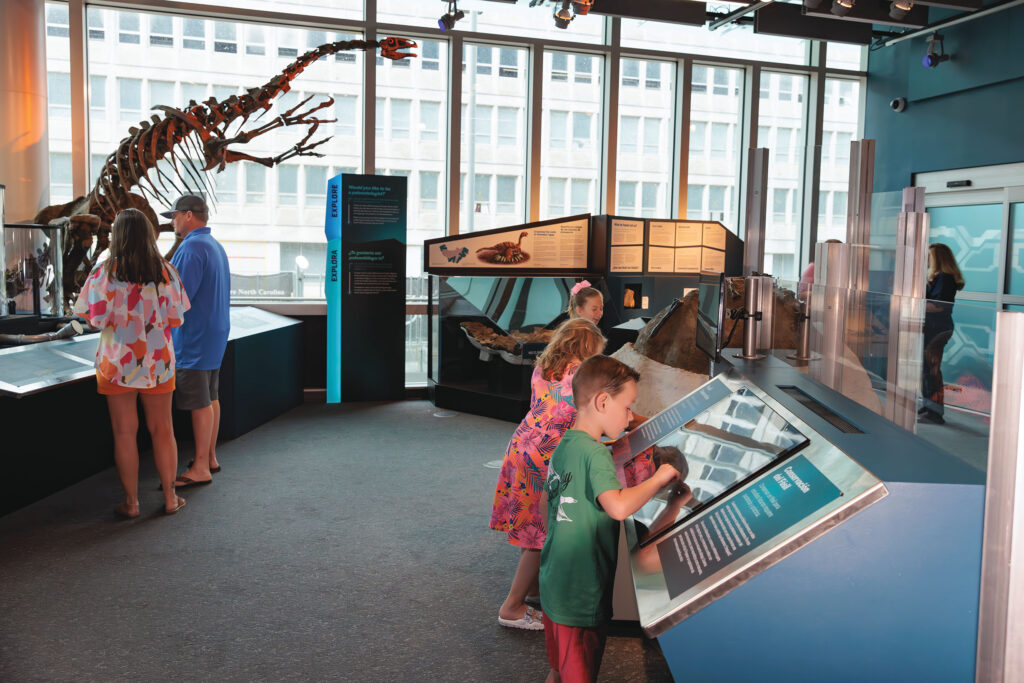Article:
PICTURED ABOVE: This illustration depicts a confrontation between juvenile tyrannosaurs and adult Triceratops, a possible scenario experienced by the Dueling Dinosaurs 67 million years ago. Dueling Dinosaurs illustration courtesy of Anthony Hutchings / © Friends of the NC Museum of Natural Sciences.
Scientists in Their Natural Habitat: The North Carolina Museum of Natural Sciences’ new Dueling Dinosaurs exhibit puts Raleigh on paleontology’s global map—and breaks down barriers between science and the public.
BY ELIZABETH BRIGNAC | PHOTOS BY JENN McKINNEY PHOTOGRAPHY UNLESS OTHERWISE NOTED
Raleigh’s North Carolina Museum of Natural Sciences (NCMNS) recently acquired two of the world’s most complete dinosaur skeletons for its Dueling Dinosaurs exhibit and opened one of the best-equipped paleontology labs in the world to study them. When the paleontologists are finished examining these fossils, the lab will investigate new ones. “Our lab here is really one of the world’s top paleontology labs. People want to come here to Raleigh to be associated with this lab,” says Kerry Irish, NCMNS’s director of communications.
If this lab were all the Dueling Dinosaurs exhibit brought to Raleigh, it would confer prestige. But what makes this exhibit globally unique is the unprecedented live-science access offered to museum visitors. Its goals are both to study fossils and show science in action. “We are the only fossil prep space in the entire world that allows visitors to come inside the lab with us on a regular basis … Visitors get to come inside the lab every single day the museum is open and talk with folks like myself or other staff members here in the lab,” says Eric Lund, NCMNS’s paleontology lab manager.
Scientists in the Dueling Dinosaurs lab do their work in view of both in-person visitors and virtual visitors via a live webcam that broadcasts lab activities. The scientists welcome guests’ questions, with each person on the team taking question-answering shifts. The goal in opening up the lab as an exhibit: to demystify science. People tend to think of scientific research as a mysterious process that goes on behind closed doors, but this sophisticated lab is producing research at the top of its field in front of anyone who cares to watch. “We are pushing the envelope of science communication and engagement with our visitors, and showing them that we are real people inside the labs … We are on the cutting edge of paleontology as a science [trying to] connect with [the public], and educate them and inspire the next generation of scientists,” says Lund.


The Exhibit’s Origins
The Dueling Dinosaurs exhibit began to take shape eight years ago. Or, if you want to be technical about it, 67 million years ago. During the Late Cretaceous period in what is now Montana, a tyrannosaur and a Triceratops were engaged in an interaction—probably “dueling or dining” as the exhibit describes it (they were either fighting, or the tyrannosaur was eating the Triceratops)—when they were buried in some kind of environmental event. Because they were buried quickly and completely, their fossils were well‑preserved.
In 2006, the fossils were discovered on private land—the most complete tyrannosaur skeleton ever found in North America and what may be one of the most complete Triceratops skeletons in the world. The fossils were priced out of range for most research facilities, and for a while, they were in danger of being relegated to obscurity in a Long Island storage facility.
In 2015, NCMNS’s head of paleontology, Dr. Lindsay Zanno, “had the idea of tearing down the veil between scientists and the general public and using paleontology and these fossils to do that,” says Lund—an approach that inspired widespread support. The nonprofit Friends of the North Carolina Museum of Natural Sciences raised contributions from donors, companies and the state of North Carolina, enabling the museum to purchase the fossils and build and equip the lab. “Many, many folks were involved in bringing together the funding for this project,” says Lund.
The process took years. There were many difficulties to overcome, even before the COVID-19 pandemic created inevitable delays and complications. But the exhibit finally opened on April 27, 2024.


Breaking down barriers
The Dueling Dinosaurs’ commitment to removing barriers between scientists and the public is part of a long-standing practice at NCMNS. One obvious hurdle the museum has overcome is financial. Permanent exhibits at NCMNS, including the Dueling Dinosaurs exhibit, are free to anyone who wants to explore them.
Another barrier is the common notion that scientific discovery is inaccessible to normal people. The idea of science as an esoteric, closed-door process bars people who might otherwise be interested from pursuing scientific inquiry and fosters public distrust in science and scientists. The museum, therefore, has been tackling that sense of mystique head-on. It utilizes glass walls for labs in the Nature Research Center, for example, so visitors can watch scientists work.
Dueling Dinosaurs is a huge step forward in the demystification process. This exhibit introduces scientists to the public as regular human beings doing a job just like anyone else. “For a million people a year who come to the museum to have an opportunity to engage with a researcher—[that can] get us over or past that hump, that most people think they don’t know a scientist or a science professional,” says Dr. Denise Young, director of NCMNS.
When they realize they’ve been talking with a team scientist, many visitors are surprised and impressed. Making science and researchers accessible inspires people to engage in scientific inquiry and encourages them to believe in its results. “Really, trying to build trust in science and the scientific process is at the core of this entire project,” says Young.

A Diverse Team
The Dueling Dinosaurs research team is demographically diverse—a deliberate choice that improves their work. “We really believe that diversity is good for science,” says Dr. Denise Young, director of NCMNS. “Different ways of thinking, different ways of knowing, different life experiences that people bring to the questions they have, the ways they approach solving them—it makes science better.”
The team’s diversity also breaks down yet another barrier between the public and science—this time, one of demographics. “That’s a comforting thing, when you walk into a place and you see people that look like you. And you’re like, ‘Oh, wow, that’s great!’ once [people] are inside, immediately breaking down those barriers that they put up to see that they belong and can fit in,” says Lund.
Cretaceous Creatures
Not only does this exhibit inspire people to believe they can understand science or become scientists—it gives kids across North Carolina the opportunity to be scientists. Cretaceous Creatures, a public science and educational arm of the Dueling Dinosaurs experience, brings millions of fossils from the layer of sediment in which the Dueling Dinosaurs were found into eighth-grade classrooms across North Carolina. Kids are taught how to examine the fossils and use NCMNS software to identify their samples.
The results: over 14,000 North Carolina kids (and counting) who are better-educated about how to think like scientists—and a broad base of data about the Dueling Dinosaurs’ environment available to researchers. A team member checks the student scientists’ findings, and then it is made available to the world. Cretaceous Creatures is one of many citizen science opportunities available at NCMNS. Click here to learn what citizen science is and about other NCMNS citizen science opportunities.


Sharing World-class Research
This scientific team is committed to sharing its results. “We have a truly world-class group of scientists at work here, and the work that they do makes waves around the world,” says Irish. “In order for science to move forward, you’ve got to share your data—so write your paper and then share [it]!” agrees Lund.
The lab’s technology makes both the research and the sharing of data more efficient than ever before. For example, CT technology allows scientists to scan fossils—from tiny teeth to specimens the size of houses—and create 3D surface scans that can be viewed as exact digital models of the fossils. Sometimes fossils are too fragile to ship, or even to cast and mold for models, but they can all be scanned. Used this way, CT technology facilitates research, preserves fragile fossils in the long term and allows researchers to share their work simply by sharing files. “We can be on opposite ends of the globe and collaborate on these things,” says Lund.
The lab also utilizes laser-based X-ray fluorescence (XRF) in exciting ways. “We know that these animals were buried as carcasses. They were buried with all their soft tissue and their skin and everything in place, so there’s potential for all that information to be preserved,” says Lund. XRF technology gives researchers information about the layers of tissue that once covered the bones, where cartilage once grew, and other information about the organic matter that once covered these bones—including (potentially) the cells that give animals their coloration.
Why Dueling Dinosaurs?
The museum could open its doors to the public on any number of large-scale scientific investigations.
To some extent, it’s because dinosaurs are cool. People want to come in and learn about them. To encourage people to observe scientific inquiry in process, the research being done must capture their attention. The public will learn what the scientists learn, and the exhibit will be updated as discoveries unfold. And no matter how old we get, dinosaurs continue to spark people’s interest. “This is a scientific mystery of incredible interest,” says Lund “[stimulating] incredible imagination … The questions we are asking inspire people’s curiosity and wonder about these creatures.”
This opinion appears to be one people share all the way up to the top. “North Carolina is the best in so many things,” Gov. Roy Cooper said happily at the opening of the Dueling Dinosaurs exhibit. “And now we’re the best in dinosaurs.”



